Spatio-Temporal Dynamics of African Swine Fever in Free-Ranging Wild Boar (Sus scrofa): Insights from Six Years of Surveillance and Control in Slovakia
Simple Summary
Abstract
1. Introduction
2. Material and Methods
2.1. Study Area
2.2. Wild Boar Management in Slovakia
2.3. ASF Surveillance Data
2.4. Estimation of the Effective Reproduction Number (Rt)
2.5. Spatio-Temporal Dynamics in ASF Prevalence
2.6. Impact of the ASF on Wild Boar Management
3. Results
3.1. Effective Reproduction Number (Rt)
3.2. Spatio-Temporal Dynamics in ASF Prevalence in Slovakia
3.3. Regional Differences in ASF Prevalence
3.4. Impact of ASF on Wild Boar Management in Slovakia
4. Discussion
Management Implications
- Maintaining low wild boar densities: ASF-related mortality combined with control measures in Slovakia has reduced wild boar densities to 0.98 ind./km2 and harvest density to 0.96 ind./km2, levels last recorded more than a decade ago. According to the European Food Safety Authority [32], maintaining wild boar densities below ~1 ind./km2 substantially reduces contact rates between individuals and thereby limits ASF transmission. Sustained hunting pressure, particularly on adult females, will therefore be essential to prevent rapid population recovery and to mitigate future outbreaks.
- Maintaining effective ASF surveillance: Surveillance should remain intensive in western Slovakia, where ASF prevalence has recently increased and where high wild boar densities combined with pig farming could facilitate rapid amplification. Early detection in this region requires continued targeted carcass searches, robust passive surveillance, and rapid carcass disposal to minimize environmental virus persistence. In the future, adaptive sampling strategies based on surveillance weights could be implemented to optimize efficiency and reduce overall monitoring costs.
- Increasing hunters’ compliance with control measures: Enhancing compliance is critical for ASF management. Financial incentives for hunters, together with stricter enforcement of regulations, may improve adherence to control measures and increase their effectiveness.
- Improving surveillance methods for wild boar population estimates: Traditional survey-based spring counts likely underestimate true population size, as harvest often exceeded pre-harvest estimates. Modernized census methods such as camera trapping, genetic mark–recapture, or drone-based surveys should be integrated to provide more accurate estimates.
- Improving scientific knowledge on wild boar population and movement dynamics: Improved data on wild boar social structure, reproduction, survival, and movement (e.g., daily ranges, corridors, and barriers) are scarce and needed to inform local targeted control and resource allocation. Such knowledge would enhance the effectiveness of ASF management strategies.
- Enhancing cross-border coordination of stakeholders: Effective ASF control requires close collaboration among stakeholders and authorities across national borders. At the EU level, this coordination is supported by harmonized frameworks such as Regulation (EU) 2023/594, which establishes common rules for ASF surveillance, zoning, and movement restrictions for pigs, wild boar, and related products to limit transboundary spread. These measures are complemented by the Standing Group of Experts on ASF in Europe under the GF-TADs initiative, which facilitates the exchange of epidemiological information and best practices among affected countries. Combining such coordinated frameworks with sustained population control, enhanced passive surveillance, and improved population estimation methods will strengthen Europe’s capacity to contain ASF and protect both wildlife and domestic pig production.
5. Conclusions
Supplementary Materials
Author Contributions
Funding
Institutional Review Board Statement
Informed Consent Statement
Data Availability Statement
Acknowledgments
Conflicts of Interest
References
- Sánchez-Cordón, P.J.; Montoya, M.; Reis, A.L.; Dixon, L.K. African swine fever: A re-emerging viral disease threatening the global pig industry. Vet. J. 2018, 233, 41–48. [Google Scholar] [CrossRef] [PubMed] [PubMed Central]
- Sauter-Louis, C.; Conraths, F.J.; Probst, C.; Blohm, U.; Schulz, K.; Sehl, J.; Fischer, M.; Forth, J.H.; Zani, L.; Depner, K.; et al. African Swine Fever in Wild Boar in Europe—A Review. Viruses 2021, 13, 1717. [Google Scholar] [CrossRef] [PubMed] [PubMed Central]
- Penrith, M.L.; Kivaria, F.M. One hundred years of African swine fever in Africa: Where have we been, where are we now, where are we going? Transbound. Emerg. Dis. 2022, 69, e1179–e1200. [Google Scholar] [CrossRef] [PubMed]
- Luisa, D.M.; Luisa, M.M.; Simona, I.; Paolo, T.; Paolo, C.; Francesco, F. African Swine Fever: Lessons to Learn From Past Eradication Experiences. A Systematic Review. Front. Vet. Sci. 2020, 7, 296. [Google Scholar] [CrossRef]
- Frant, M.P.; Gal-Cisoń, A.; Bocian, Ł.; Ziętek-Barszcz, A.; Niemczuk, K.; Szczotka-Bochniarz, A. African Swine Fever (ASF) Trend Analysis in Wild Boar in Poland (2014–2020). Animals 2022, 12, 1170. [Google Scholar] [CrossRef] [PubMed]
- Náhlik, A.; Erdélyi, K.; Bálint, A.; Tari, T. African Swine Fever (ASF) in Hungary—History of the First Year After the Outbreak. In Proceedings of the 34th International Union of Game Biologists (IUGB) Congress, Kaunas, Lithuania, 26–30 August 2019. [Google Scholar]
- Gallardo, M.C.; de la Torre Reoyo, A.; Fernández-Pinero, J.; Iglesias, I.; Muñoz, M.J.; Arias, M.L. African swine fever: A global view of the current challenge. Porc. Health Manag. 2015, 1, 21. [Google Scholar] [CrossRef]
- Guberti, V.; Khomenko, S.; Masiulis, M.; Kerba, S.; Pittiglio, C. African Swine Fever in Wild Boar: Ecology and Biosecurity. FAO Animal Production and Health Manual; FAO: Rome, Italy, 2019. [Google Scholar]
- Ferran, J.; Giovanna, M.; Licoppe, A.; Francisco, R.-F.; Annick, L.; Petr, V.; Erika, C.; Carme, R. Management of wild boar populations in the European Union before and during the ASF crisis. In Understanding and Combatting African Swine Fever. An European Perspective; Wageningen Academic Publishers: Wageningen, The Netherlands, 2021. [Google Scholar] [CrossRef]
- Migliore, S.; Hussein, H.A.; Galluzzo, P.; Puleio, R.; Loria, G.R. African Swine Fever and Its Control Measures in Wild Boar: A “De Iure Condito” Analysis in the European Union. Animals 2023, 14, 14. [Google Scholar] [CrossRef] [PubMed] [PubMed Central]
- State Veterinary and Food Administration of the Slovak Republic. Národný Eradikačný Program pre Africký mor Ošípaných v Diviačej Populácii na Slovensku v Roku 2020 [National Eradication Plan for African Swine Fever in Wild Boar Population in Slovakia in 2020]; State Veterinary and Food Administration of the Slovak Republic: Bratislava, Slovakia, 2020. [Google Scholar]
- State Veterinary and Food Administration of the Slovak Republic. Národný Eradikačný Program pre Africký mor Ošípaných v Diviačej Populácii na Slovensku v Roku 2025 [National Eradication Plan for African Swine Fever in Wild Boar Population in Slovakia in 2025]; State Veterinary and Food Administration of the Slovak Republic: Bratislava, Slovakia, 2025. [Google Scholar]
- Beltran-Alcrudo, D.; Falco, J.R.; Raizman, E.; Dietze, K. Transboundary spread of pig diseases: The role of international trade and travel. BMC Vet. Res. 2019, 15, 64. [Google Scholar] [CrossRef]
- Oelke, J.; Jarynowski, A. Sovereignty Beyond the Human: ASF in the German-Polish Borderland. DIE ERDE—J. Geogr. Soc. Berl. 2025, 155, 133–146. [Google Scholar]
- EFSA (European Food Safety Authority); EFSA Panel on Animal Health and Welfare (AHAW); Nielsen, S.S.; Alvarez, J.; Bicout, D.J.; Calistri, P.; Depner, K.; Drewe, J.A.; Garin-Bastuji, B.; Gonzales Rojas, J.L.; et al. Scientific Opinion on the assessment of the control measures of the category A diseases of Animal Health Law: African Swine Fever. EFSA J. 2021, 19, e06402. [Google Scholar] [CrossRef]
- Massei, G.; Kindberg, J.; Licoppe, A.; Gačić, D.; Šprem, N.; Kamler, J.; Baubet, E.; Hohmann, U.; Monaco, A.; Ozoliņš, J.; et al. Wild boar populations up, numbers of hunters down? A review of trends and implications for Europe. Pest Manag. Sci. 2015, 71, 492–500. [Google Scholar] [CrossRef] [PubMed]
- Štofík, J.; Bučko, J. Zmeny v poľovnom manažmente najvýznamnejších druhov poľovnej zveri na slovensku po II. Svetovej vojne (1949–2015)/Changes of the hunting management of the most important ungulate species in Slovakia after World War II. (1949–2015). Acta Fac. For. 2020, 61/2, 21–32. [Google Scholar]
- NFC SR (National Forest Centre of the Slovak Republic). Integrated System of Hunting and Population Management (ISLHP) Database; NFC SR (National Forest Centre of the Slovak Republic): Zvolen, Slovakia, 2025. [Google Scholar]
- CORINE Land Cover 2018 European Copernicus Programme. Available online: https://land.copernicus.eu/en/products/corine-land-cover (accessed on 10 July 2025).
- Smolko, P.; Garaj, P.; Lebocký, T.; Bútora, Ľ.; Pataky, T.; Jaňáková, Z.; Babic, M.; Veselovská, A.; Kubala, J.; Kropil, R. Soil nutrients and deer density affect antler size of the Carpathian red deer. Mamm. Biol. 2022, 102, 119–130. [Google Scholar] [CrossRef]
- Guimarães, N.F.; Álvares, F.; Ďurová, J.; Urban, P.; Bučko, J.; Iľko, T.; Brndiar, J.; Štofik, J.; Pataky, T.; Barančeková, M.; et al. What drives wolf preference towards wild ungulates? Insights from a multi-prey system in the Slovak Carpathians. PLoS ONE 2022, 17, e0265386. [Google Scholar] [CrossRef]
- Cori, A.; Ferguson, N.M.; Fraser, C.; Cauchemez, S. A new framework and software to estimate time-varying reproduction numbers during epidemics. Am. J. Epidemiol. 2013, 178, 1505–1512. [Google Scholar] [CrossRef]
- R Core Team. R (Version 4.1.3): A Language and Environment for Statistical Computing. R Foundation for Statistical Computing; R Core Team: Vienna, Austria, 2022. [Google Scholar]
- Lange, M.; Guberti, V.; Thulke, H.H. Understanding ASF spread and persistence in wild boar populations: A modeling approach. Prev. Vet. Med. 2017, 135, 123–133. [Google Scholar]
- OpenAI. ChatGPT, (Version GPT-5); OpenAI: San Francisco, CA, USA, 2025. Available online: https://chat.openai.com (accessed on 15 July 2025).
- Greiner, M.; Gardner, I.A. Epidemiologic issues in the validation of veterinary diagnostic tests. Prev. Vet. Med. 2000, 45, 3–22. [Google Scholar] [CrossRef]
- Miller, M.W.; Wolfe, L.L. Inferring Chronic Wasting Disease Incidence from Prevalence Data. J. Wildl. Dis. 2021, 57, 718–721. [Google Scholar] [CrossRef]
- EFSA (European Food Safety Authority); Nielsen, S.S.; Alvarez, J.; Bicout, D.J.; Calistri, P.; Depner, K.; Drewe, J.A.; Garin-Bastuji, B.; Gonzales Rojas, J.L.; Gortazar Schmidt, C.; et al. ASF Exit Strategy: Providing cumulative evidence of the absence of African swine fever virus circulation in wild boar populations using standard surveillance measures. EFSA J. 2021, 19, e06419. [Google Scholar] [CrossRef]
- Loi, F.; Cappai, S.; Laddomada, A.; Feliziani, F.; Oggiano, A.; Franzoni, G.; Rolesu, S.; Guberti, V. Mathematical Approach to Estimating the Main Epidemiological Parameters of African Swine Fever in Wild Boar. Vaccines 2020, 8, 521. [Google Scholar] [CrossRef] [PubMed]
- Schambow, R.A.; Carrasquillo, N.; Kreindel, S.; Perez, A.M. An update on active and passive surveillance for African swine fever in the Dominican Republic. Sci. Rep. 2025, 15, 2244. [Google Scholar] [CrossRef]
- Rogoll, L.; Güttner, A.K.; Schulz, K.; Bergmann, H.; Staubach, C.; Conraths, F.J.; Sauter-Louis, C. Seasonal Occurrence of African Swine Fever in Wild Boar and Domestic Pigs in EU Member States. Viruses 2023, 15, 1955. [Google Scholar] [CrossRef]
- EFSA (European Food Safety Authority); Ståhl, K.; Boklund, A.E.; Podgórski, T.; Vergne, T.; Aminalragia-Giamini, R.; Abrahantes, J.C.; Papaleo, S.; Mur, L. Epidemiological analysis of African swine fever in the European Union during 2024. EFSA J. 2025, 23, e9436. [Google Scholar] [CrossRef]
- Bergmann, H.; Schulz, K.; Conraths, F.J.; Sauter-Louis, C. A Review of Environmental Risk Factors for African Swine Fever in European Wild Boar. Animals 2021, 11, 2692. [Google Scholar] [CrossRef]
- Pepin, K.M.; Golnar, A.J.; Abdo, Z.; Podgórski, T. Ecological drivers of African swine fever virus persistence in wild boar populations: Insight for control. Ecol. Evol. 2020, 10, 2846–2859. [Google Scholar] [CrossRef] [PubMed]
- Olesen, A.S.; Lohse, L.; Boklund, A.; Halasa, T.; Belsham, G.J.; Rasmussen, T.B.; Bøtner, A. Short time window for transmissibility of African swine fever virus from a contaminated environment. Transbound. Emerg. Dis. 2018, 65, 1024–1032. [Google Scholar] [CrossRef]
- Mazur-Panasiuk, N.; Wozniakowski, G. Natural inactivation of African swine fever virus in tissues: Influence of temperature and environmental conditions on virus survival. Vet. Microbiol. 2020, 242, 108609. [Google Scholar] [CrossRef]
- Schulz, K.; Oļševskis, E.; Viltrop, A.; Masiulis, M.; Staubach, C.; Nurmoja, I.; Lamberga, K.; Seržants, M.; Malakauskas, A.; Conraths, F.J.; et al. Eight Years of African Swine Fever in the Baltic States: Epidemiological Reflections. Pathogens 2022, 11, 711. [Google Scholar] [CrossRef] [PubMed]
- Tarvydas, A.; Belova, O. Effect of Wild Boar (Sus scrofa L.) on Forests, Agricultural Lands and Population Management in Lithuania. Diversity 2022, 14, 801. [Google Scholar] [CrossRef]
- Mačiulskis, P.; Masiulis, M.; Pridotkas, G.; Buitkuvienė, J.; Jurgelevičius, V.; Jacevičienė, I.; Zagrabskaitė, R.; Zani, L.; Pilevičienė, S. The African Swine Fever Epidemic in Wild Boar (Sus scrofa) in Lithuania (2014–2018). Vet. Sci. 2020, 7, 15. [Google Scholar] [CrossRef]
- Chenais, E.; Depner, K.; Guberti, V.; Dietze, K.; Viltrop, A.; Ståhl, K. Epidemiological considerations on African swine fever in Europe 2014–2018. Porc. Health Manag. 2019, 5, 6. [Google Scholar] [CrossRef] [PubMed]
- Bieber, C.; Ruf, T. Population dynamics in wild boar Sus scrofa: Ecology, elasticity of growth rate and implications for the management of pulsed resource consumers. J. Appl. Ecol. 2005, 42, 1203–1213. [Google Scholar] [CrossRef]
- Bartoš, L.; Turek, K.; Křístek, Š.; Bartošova, J. Wild Boar Paradox—Intensive Hunting Boosts Population Increase. JOJ Wildl. Biodivers. 2025, 54, 555667. [Google Scholar] [CrossRef]
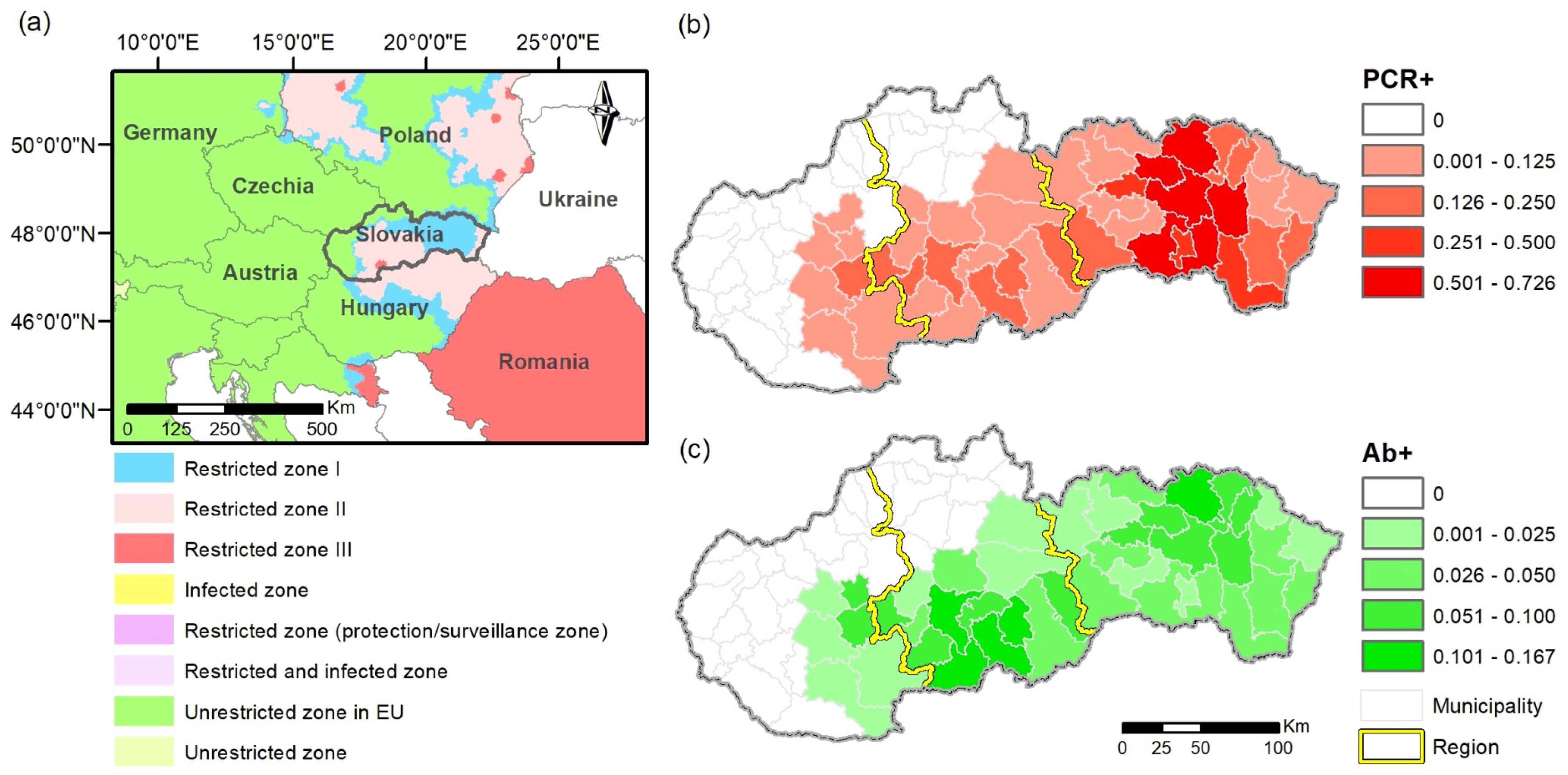
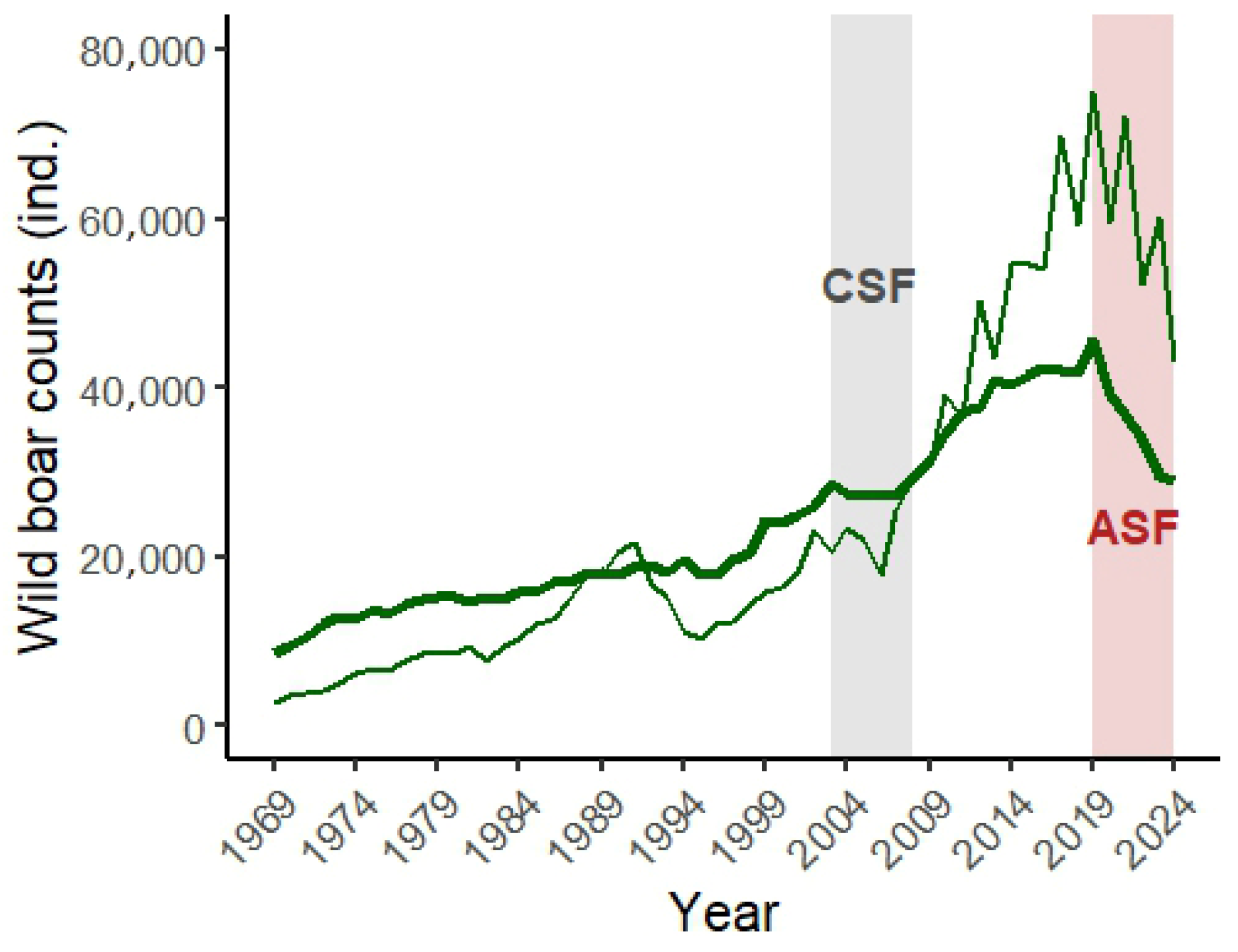

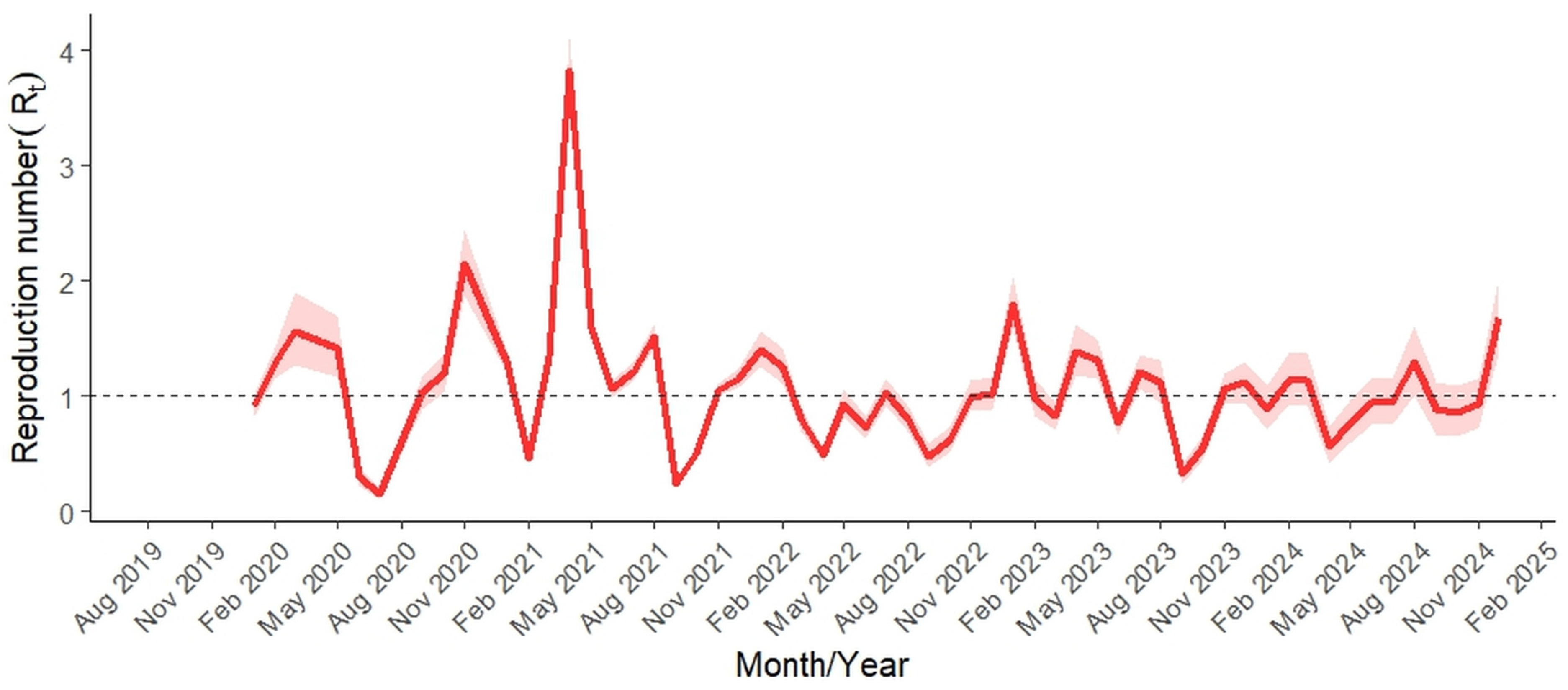
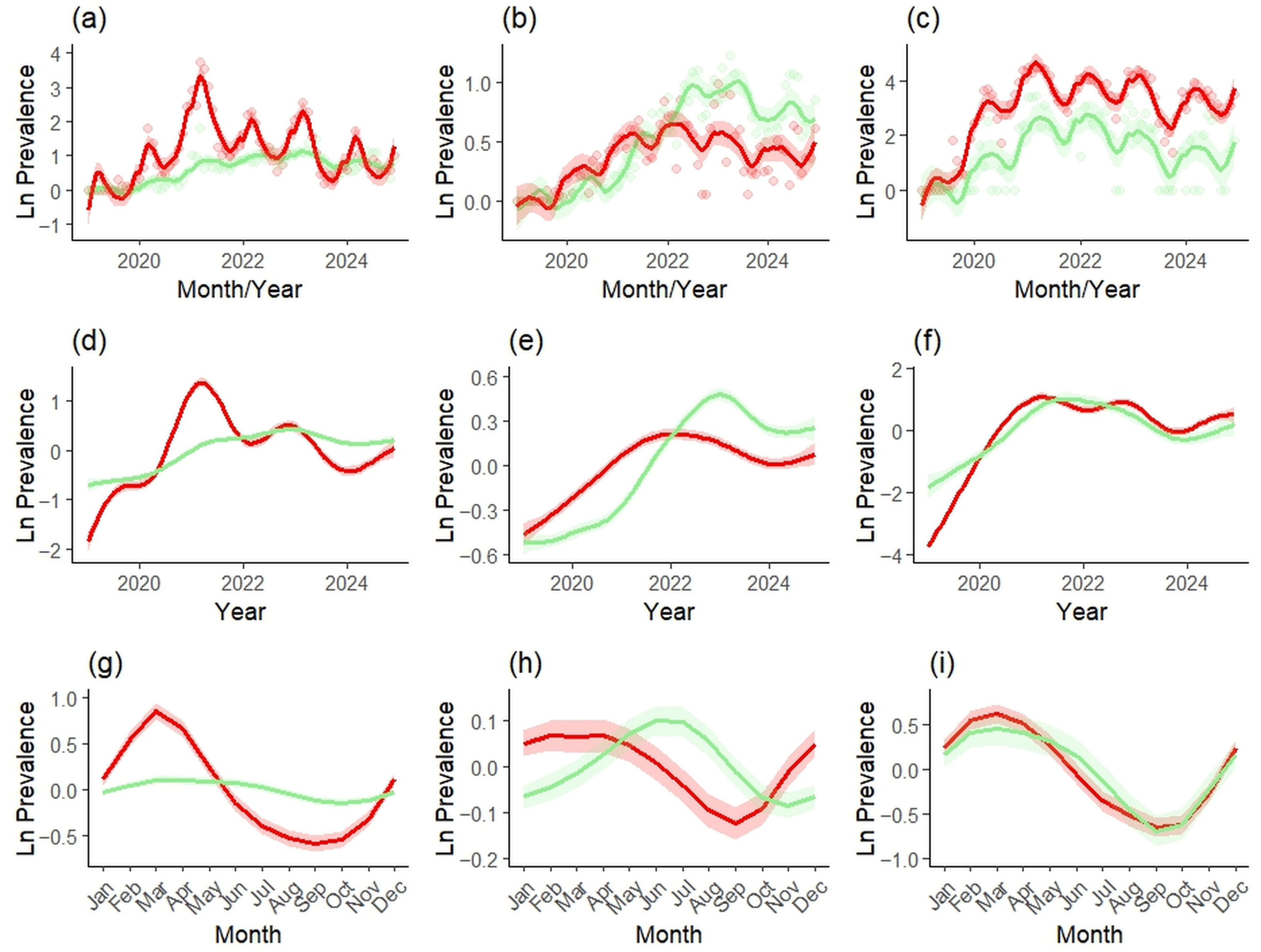
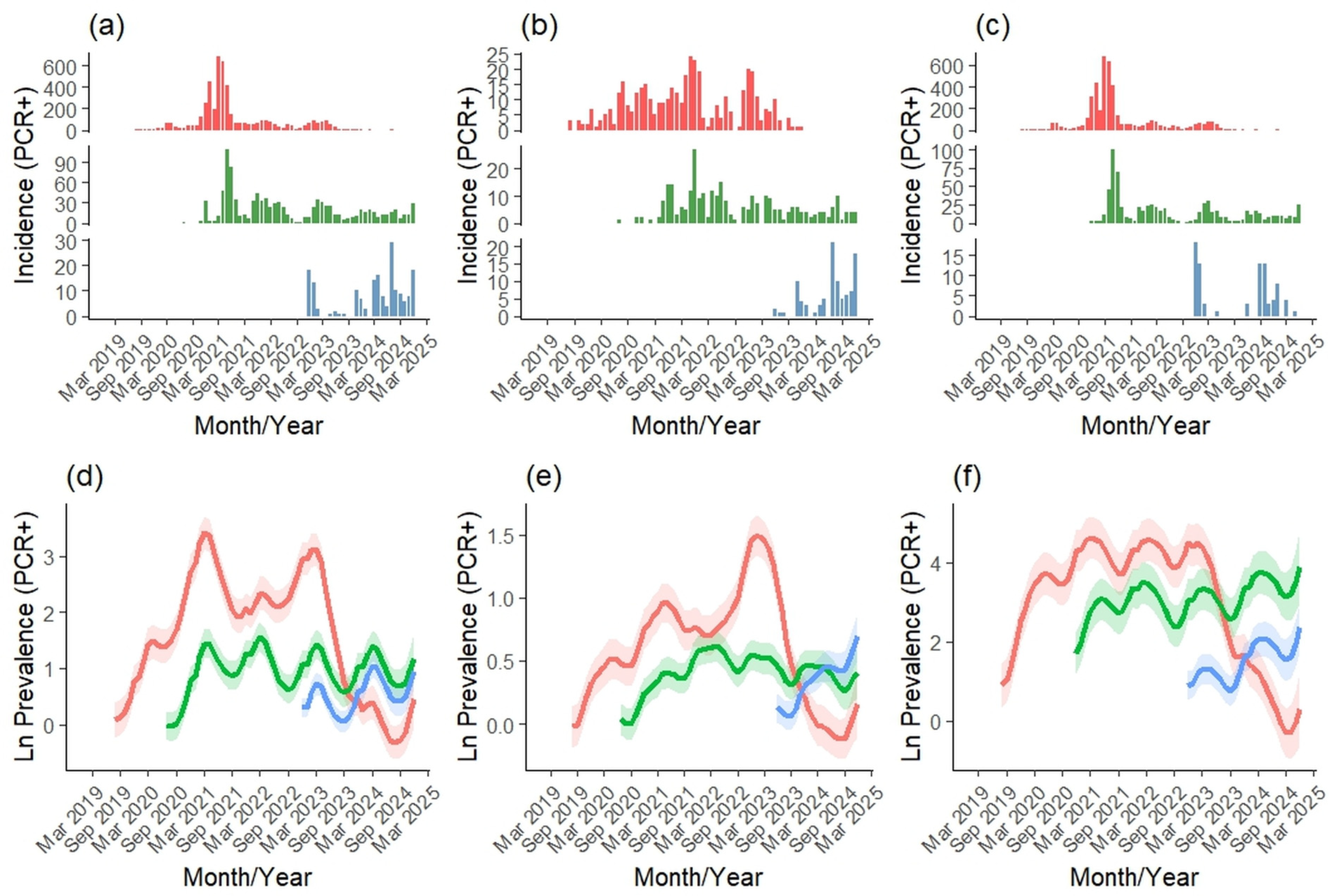
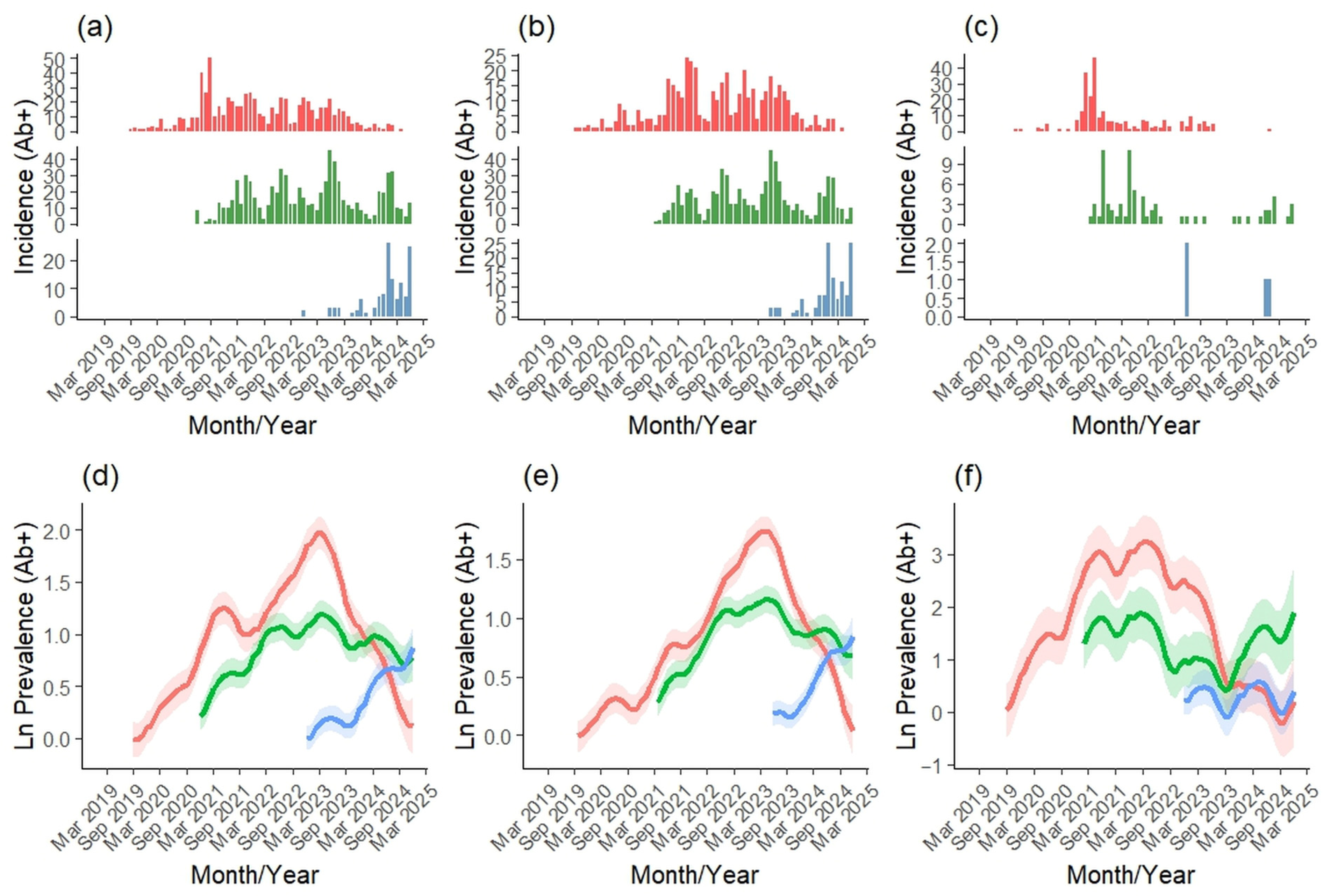
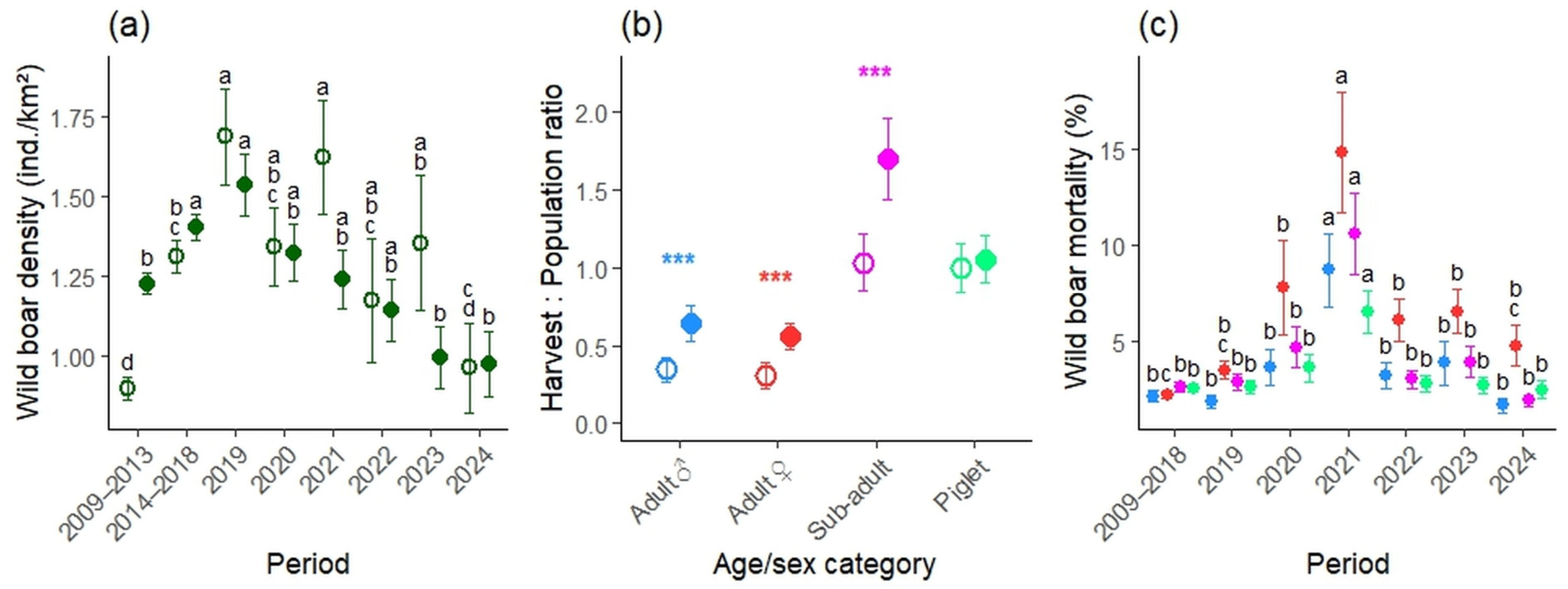
| Test/ Year | Overall ASF Monitoring | Active ASF Monitoring | Passive ASF Monitoring | |||||||
|---|---|---|---|---|---|---|---|---|---|---|
| ASF− | ASF+ | Prev. | ASF− | ASF+ | Prev. | ASF− | ASF+ | Prev. | ||
| 2019 | 34,925 | 32 | 0.1 | 33,514 | 10 | 0.0 | 1415 | 22 | 1.5 | |
| 2020 | 29,657 | 738 | 2.4 | 29,024 | 98 | 0.3 | 1066 | 679 | 38.9 | |
| 2021 | 33,225 | 3283 | 9.0 | 32,105 | 250 | 0.8 | 1493 | 3033 | 67.0 | |
| PCR | 2022 | 23,212 | 817 | 3.4 | 22,520 | 173 | 0.8 | 692 | 644 | 48.2 |
| 2023 | 26,917 | 679 | 2.5 | 26,209 | 151 | 0.6 | 707 | 528 | 42.8 | |
| 2024 | 23,445 | 306 | 1.3 | 22,966 | 127 | 0.5 | 482 | 179 | 27.1 | |
| ∑ | 171,381 | 5855 | 166,338 | 809 | 5855 | 5085 | ||||
| 2019 | 34,331 | 5 | 0.0 | 33,515 | 3 | 0.0 | 820 | 2 | 0.2 | |
| 2020 | 29,348 | 66 | 0.2 | 29,071 | 40 | 0.1 | 728 | 28 | 3.7 | |
| 2021 | 32,900 | 430 | 1.3 | 32,105 | 232 | 0.7 | 1159 | 198 | 14.6 | |
| Ab | 2022 | 22,801 | 384 | 1.7 | 22,349 | 329 | 1.5 | 452 | 55 | 10.8 |
| 2023 | 26,449 | 400 | 1.5 | 25,969 | 370 | 1.4 | 479 | 30 | 5.9 | |
| 2024 | 23,170 | 299 | 1.3 | 22,811 | 282 | 1.2 | 362 | 17 | 4.5 | |
| ∑ | 168,999 | 1584 | 165,820 | 1256 | 4000 | 330 | ||||
| Test | Model | Smooth Term | Overall Monitoring | Active Monitoring | Passive Monitoring | |||
|---|---|---|---|---|---|---|---|---|
| β/edf | t/F | β/edf | t/F | β/edf | t/F | |||
| PCR | Slovakia | s(Date) | 8.4 | 42.64 *** | 4.4 | 17.09 *** | 7.22 | 68.60 *** |
| s(Month) | 5.13 | 16.07 *** | 2.83 | 1.37 ** | 4.18 | 7.81 *** | ||
| R2 | 83.4 | 58.9 | 79.4 | |||||
| Regional | Region: East | 1.43 | 29.74 *** | 0.54 | 20.78 *** | 2.75 | 27.87 *** | |
| Region: Center | 0.72 | −10.49 *** | 0.30 | −6.51.51 *** | 2.13 | −4.48 *** | ||
| Region: West | 0.19 | −18.27 *** | 0.09 | −12.23 *** | 0.57 | −15.64 *** | ||
| te(Date, Region) East | 8.34 | 59.65 *** | 8.33 | 34.59 *** | 6.42 | 37.44 *** | ||
| te(Date, Region) Center | 5.83 | 14.82 *** | 4.49 | 12.34 *** | 6.17 | 29.52 *** | ||
| te(Date, Region) West | 2.46 | 11.52 *** | 3.45 | 11.70 *** | 2.56 | 17.83 *** | ||
| s(Month) | 4.21 | 9.86 *** | 3.42 | 1.92 *** | 3.35 | 3.22 *** | ||
| R2 | 90.1 | 73.1 | 89.6 | |||||
| Ab | Slovakia | s(Date) | 5.89 | 28.17 *** | 6.01 | 52.48 *** | 4.83 | 11.32 *** |
| s(Month) | 2.53 | 1.24 ** | 2.61 | 1.48 *** | 2.97 | 1.86 *** | ||
| R2 | 77.3 | 84.6 | 53.3 | |||||
| Regional | Region: East | 0.86 | 31.58 *** | 0.71 | 31.60 *** | 1.49 | 14.70 *** | |
| Region: Center | 0.59 | 10.49 *** | 0.53 | −5.42 *** | 0.90 | −4.08 *** | ||
| Region: West | 0.12 | 18.27 *** | 0.13 | −18.51 *** | 0.12 | −9.60 *** | ||
| te(Date, Region) East | 7.82 | 56.40 *** | 7.65 | 73.72 *** | 5.33 | 20.05 *** | ||
| te(Date, Region) Center | 5.12 | 41.67 *** | 6.20 | 54.79 *** | 5.35 | 7.31 *** | ||
| te(Date, Region) West | 4.02 | 16.36 *** | 4.40 | 21.78 *** | 1.00 | 2.16 | ||
| s(Month) | 3.02 | 2.23 *** | 2.83 | 1.91 *** | 2.82 | 1.61 *** | ||
| R2 | 84.9 | 87.7 | 56.6 | |||||
Disclaimer/Publisher’s Note: The statements, opinions and data contained in all publications are solely those of the individual author(s) and contributor(s) and not of MDPI and/or the editor(s). MDPI and/or the editor(s) disclaim responsibility for any injury to people or property resulting from any ideas, methods, instructions or products referred to in the content. |
© 2025 by the authors. Licensee MDPI, Basel, Switzerland. This article is an open access article distributed under the terms and conditions of the Creative Commons Attribution (CC BY) license (https://creativecommons.org/licenses/by/4.0/).
Share and Cite
Smolko, P.; Bučko, J.; Štefanec, M.; Lebocký, T.; Chudý, M.; Janto, R.; Kubek, F.; Kropil, R. Spatio-Temporal Dynamics of African Swine Fever in Free-Ranging Wild Boar (Sus scrofa): Insights from Six Years of Surveillance and Control in Slovakia. Vet. Sci. 2025, 12, 1027. https://doi.org/10.3390/vetsci12111027
Smolko P, Bučko J, Štefanec M, Lebocký T, Chudý M, Janto R, Kubek F, Kropil R. Spatio-Temporal Dynamics of African Swine Fever in Free-Ranging Wild Boar (Sus scrofa): Insights from Six Years of Surveillance and Control in Slovakia. Veterinary Sciences. 2025; 12(11):1027. https://doi.org/10.3390/vetsci12111027
Chicago/Turabian StyleSmolko, Peter, Jozef Bučko, Marek Štefanec, Tibor Lebocký, Martin Chudý, Rudolf Janto, Filip Kubek, and Rudolf Kropil. 2025. "Spatio-Temporal Dynamics of African Swine Fever in Free-Ranging Wild Boar (Sus scrofa): Insights from Six Years of Surveillance and Control in Slovakia" Veterinary Sciences 12, no. 11: 1027. https://doi.org/10.3390/vetsci12111027
APA StyleSmolko, P., Bučko, J., Štefanec, M., Lebocký, T., Chudý, M., Janto, R., Kubek, F., & Kropil, R. (2025). Spatio-Temporal Dynamics of African Swine Fever in Free-Ranging Wild Boar (Sus scrofa): Insights from Six Years of Surveillance and Control in Slovakia. Veterinary Sciences, 12(11), 1027. https://doi.org/10.3390/vetsci12111027





